This article was published in Scientific American’s former blog network and reflects the views of the author, not necessarily those of Scientific American
In an article published here back in November 2016, I discussed the very weird and highly elaborate nasal region of the ceratopsids – the group of ornithischian dinosaurs that includes Triceratops. That article was meant to be part 1 in a short series, and today we embark on part 2.
This time, we move away from the nasal region and think instead about the skull roof, specifically at the region in between the eyes, and thus between the brow horns (or their homologues: brow horns are absent in many ceratopsids, and sometimes even replaced by crater-like structures). Here we find one of the weirdest, most fascinating details of the ceratopsid skull: a deep, flask-shaped cavity in the skull roof termed the frontal sinus, cranial sinus or supracranial sinus. This is a large structure positioned above the brain and involving most bones in this region of the skull (the frontals, parietals, postorbitals, exoccipitals, supraoccipital and laterosphenoids). It’s especially large and complex in Triceratops (Forster 1996, Farke 2010). Its position means that the brain is not at all close to the skull roof, but actually deep down inside the skull, lower even than the position of the eye sockets (Farke 2006, 2010).

The braincase of Triceratops as illustrated in section, anterior to the right, by Lull (1933). The base of the left horncore is visible at the top, the rounded occipital condyle is visible at lower left, and the horizontal cavity for the brain is visible about half-way up. In red... or pink.. we see the large supracranial sinus and its various subdivisions and structures. Credit: Lull 1933
On supporting science journalism
If you're enjoying this article, consider supporting our award-winning journalism by subscribing. By purchasing a subscription you are helping to ensure the future of impactful stories about the discoveries and ideas shaping our world today.
An opening originally termed the postfrontal fontanelle but later renamed the frontal fontanelle connects the sinus to the outside world in most of these animals but not all of them; indeed, the way in which the sinus is roofed varies quite a bit. In some taxa, the sinus is completely roofed over by bone, only the circular fontanelle being present. This is the case in Arrhinoceratops and many Triceratops horridus specimens. In others (some Chasmosaurus specimens), there are projecting bony tongues that partially roof the sinus but it’s otherwise open to the sky. Triceratops prorsus is unique in that it lacks “any indication than a frontal fontanelle was ever present” (Forster 1996, p. 251). The weird anatomical novelty of this structure is one thing; its variability is something else altogether.
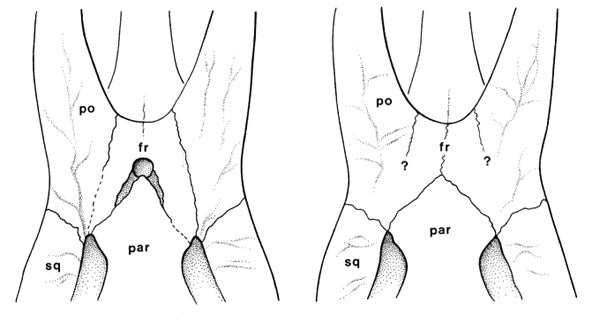
It’s weird enough that the supracranial sinus exists, but the fact that its external opening is wholly absent in one species is even weirder. At left, we see the condition in Triceratops horridus, and at right what’s present in T. prorsus. Credit: Forster 1996
A few accessory structures are associated with the sinus: a bony wall termed the transverse buttress divides the sinus (in some animals, not all) into anterior and posterior sections (Forster 1996), the posterior of which is typically deeper. Accessory buttresses anterior to the main transverse one divide the sinus’s anterior chamber in some taxa (Farke 2010).
As usual, we’re left with numerous questions about this structure, its homology, origins, its relations to other details of skull anatomy, and its function. And again we’re constrained by only being able to observe its bony anatomy: we essentially know nothing of the soft tissues that would have been involved as well. The sinus wasn’t, of course, really “open to the sky”: there would have been skin, membranes and other structures forming its upper boundaries and stuff of some sort (hey, let’s be as specific as possible) would presumably have occupied its interior.
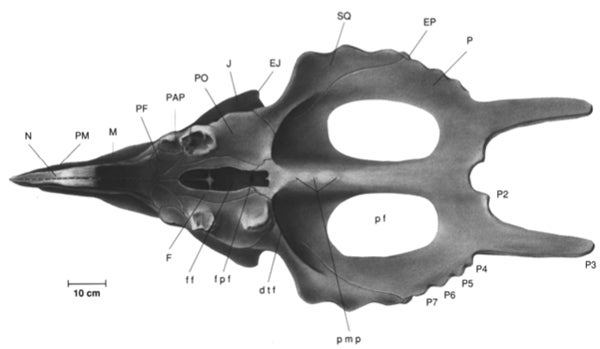
Skull of the centrosaurine ceratopsid Einiosaurus in dorsal view (from Sampson 1995), displaying well the enormous size and conspicuous nature of the supracranial sinus in this animal. Credit: Sampson 1995
The sinus probably originated as an outgrowth of the cranial pneumatic system, though it cannot yet be determined which of the various of these systems it was linked to – the paranasal, paratympanic or pharyngeal one. Indeed, no direct link with any part of the cranial pneumatic system has yet been detected, despite several careful efforts (Forster 1996, Sampson et al. 1997, Witmer 1997, Farke 2006, 2010).
Several possible functions for the sinus have been proposed. Haas (1955) suggested that muscles from the supratemporal region anchored within the sinus but this makes little sense in view of how muscles are actually arranged in that part of the skull, nor is it consistent with the fact that some species – and even some individuals within some species – have a closed fontanelle (Dodson & Currie 1992, Godfrey & Holmes 1995, Forster 1996).
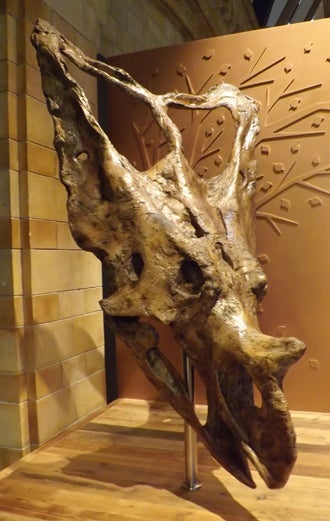
Replica skull of the Chasmosaurus belli specimen ROM 843. You can’t see all the details, but you should at least be able to see something interesting going on in the region between the eyes. Credit: Darren Naish
More popular is the idea that the sinus served some sort of cushioning or stress dissipation function that was important in preventing or minimising cranial damage during intraspecific combat. This possibility is mostly based on the widespread assumption that the cranial sinuses of bovids have a ‘cushioning’ function… but it turns out that this assumed function is not at all well founded, may be wrong, and is inconsistent with the position of the sinuses relative to the horns (Farke 2008). Having said that, the ceratopsid sinus is better placed to function as a ‘cushioning’ structure, the fact that the sinus separates the horns from the braincase potentially being beneficial in view of the fighting style practised by these animals (it involved interlocking the horns and twisting to the side: Farke 2004).
A number of other possible functions have been considered. A thermoregulatory role of some kind is suggested by the presence of neurovascular channels that link the sinus with the horncores: could an exchange of bloodflow between these regions be linked to brain cooling? Could the sinus be something to do with weight reduction? This is unlikely, in part because the reduction we’re talking about appears negligible given the mass of the skull as a whole (we’re talking c 6.5 kg from c 220 kg: Farke 2010). And of course there’s also the possibility that the sinus had no special ‘function’ at all but was a developmental consequence of skull growth: virtually everything about the ceratopsid skull is hypertrophied and exaggerated relative to the condition in their ancestors, so could it be that skull deepening resulted in an enlargement and deepening of the shallow depression present in earlier, small ceratopsians? (Farke 2010).
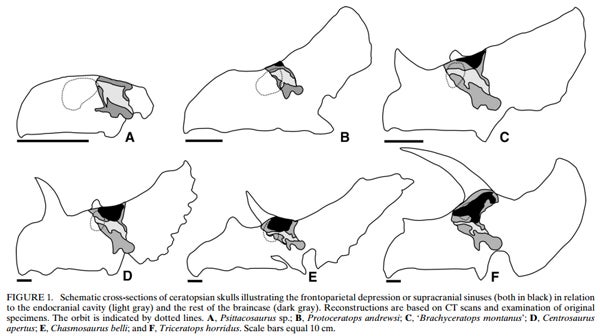
Supracranial sinuses - and their probable antecedents: frontoparietal depressions - shown in a variety of ceratopsians (marked in black). Note the large size and complexity of the sinus in Triceratops (F). Credit: Farke 2010
The sinus is more extensive in some taxa than others: in some chasmosaurines (Pentaceratops, Torosaurus and Triceratops among them), it sends branches sideways and upwards into the bases of the brow horns, the results being cornual sinuses that occupy the basal third or so (actually between 8% and 27%) of each horn (Farke 2006). The presence of such structures won’t be surprising to you if you know anything about horn anatomy in modern horned mammals, but I still think it’s unexpected given that most people assume horns to be solid.
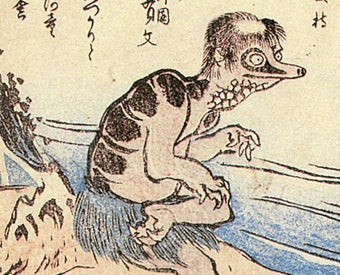
If you bow in front of a ceratopsid, will it lose the liquid in its supracranial sinus and become weakened and helpless? Some of you will understand this reference. Credit: Kyoka Hyaku-Monogatari Wikimedia
Finally, is it possible that the sinus had some novel role or function that we haven’t considered? Could it have been something to do with sending sound beams or making resonating calls? Might it have housed a gland? Did it contain a magical jewel or special liquid that proved the very life force and ensured the vitality and immortality of its owner? Questions questions. We’re entering a new phase of research on the anatomy of extinct animals whereby high-resolution CT scanning is illuminating many internal details that have previously been difficult to visualise and understand. Andrew Farke had made significant headway... ha ha... on the supracranial sinus already (Farke 2010) but more work of this sort could well be done in future… in view of this, it may only be a matter of time before we have an improved handle on this most unusual and fascinating structure.
For previous Tet Zoo articles on ceratopsians (many of these articles are now quite dated), see…
Tet Zoo picture of the day # 11 (or, speculations on omnivory in ceratopsids)
SVPCA 2007: dinosaurs attack (includes stuff on Psittacosaurus)
A month in dinosaurs (and pterosaurs): 3, Minotaurasaurus and giant chasmosaurines
Zuniceratops and the early acquisition and alleged dimorphism of ceratopsian brow horns
Did dinosaurs and pterosaurs practise mutual sexual selection?
Ryan et al.'s New Perspectives on Horned Dinosaurs: a review
Dinosaurs and their exaggerated structures: species recognition aids, or sexual display devices?
Refs - -
Dodson, P. & Currie, P. J. 1992. Neoceratopsia. In Weishampel, D. B., Dodson, P. & Osmólska, H. (eds) The Dinosauria (University of California Press, Berkeley), pp. 593-618.
Farke, A. A. 2004. Horn use in Triceratops (Dinosauria: Ceratopsidae): testing behavioral hypotheses using scale models. Palaeontologia Electronica 7 (1): 10p.
Farke, A. A. 2006. Morphology and ontogeny of the cornual sinuses in chasmosaurine dinosaurs (Ornithischia: Ceratopsidae). Journal of Paleontology 80, 780-785.
Farke, A. A. 2008. Frontal sinuses and head-butting in goats: a finite element analysis. Journal of Experimental Biology 211, 3085-3094.
Farke, A. A. 2010. Evolution, homology, and function of the supracranial sinuses in ceratopsian dinosaurs. Journal of Vertebrate Paleontology 30, 1486-1500.
Forster, C. A. 1996. New information on the skull of Triceratops. Journal of Vertebrate Paleontology 16, 246-258.
Godfrey, S. J. & Holmes, R. 1995. Cranial morphology and systematics of Chasmosaurus (Dinosauria: Ceratopsidae) from the Upper Cretaceous of western Canada. Journal of Vertebrate Paleontology 15, 726-742.
Haas, G. 1955. The jaw musculature of Protoceratops and other in other ceratopsians. American Museum Novitates 1729, 1-24.
Lull, R. S. 1933. A revision of the Ceratopsia or horned dinosaurs. Memoirs of the Peabody Museum of Natural History 3, 1-175.
Sampson, S. D. 1995. Two new horned dinosaurs from the Upper Cretaceous Two Medicine Formation of Montana; with a phylogenetic analysis of the Centrosaurinae (Ornithischia: Ceratopsidae). Journal of Vertebrate Paleontology 15, 743-760.
Sampson, S. D., Ryan, M. J. & Tanke, D. H. 1997. Craniofacial ontogeny in centrosaurine dinosaurs (Ornithischia: Ceratopsidae): Taxonomic and behavioural implications. Zoological Journal of the Linnean Society 121, 293-337.
Witmer, L. M. 1997. Craniofacial air sinus systems. In Currie, P. J. & Padian, K. (eds.), Encyclopedia of Dinosaurs. Academic Press, San Diego, pp. 151-159.